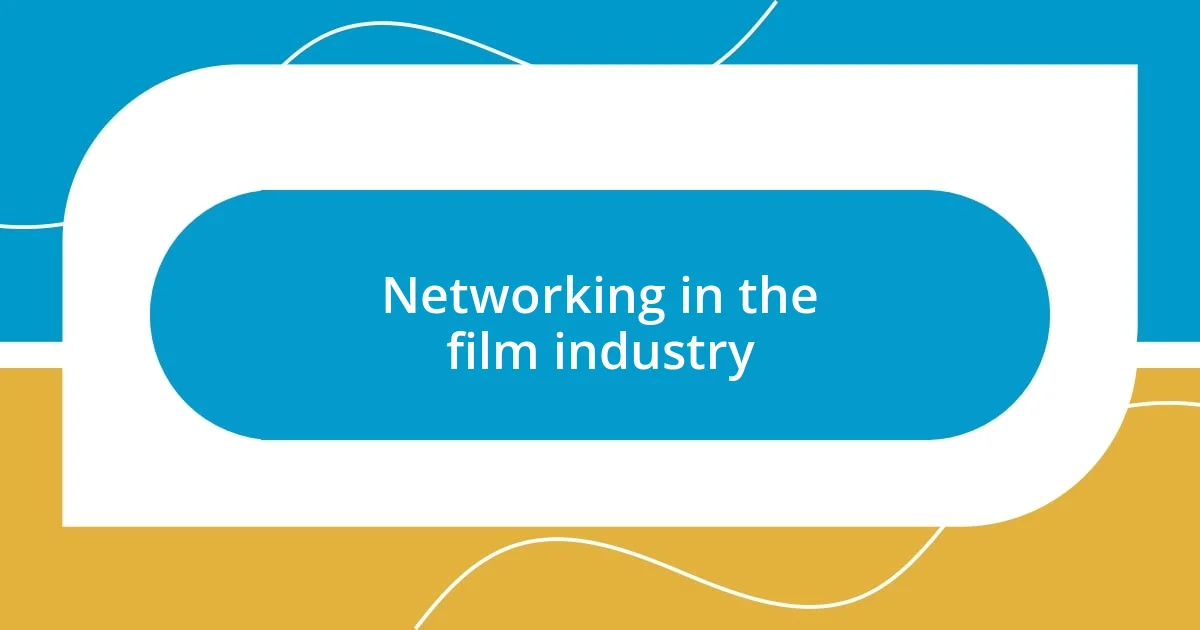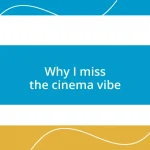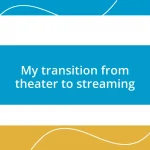Key takeaways:
- Understanding the interconnected roles in a film crew is vital; every position, no matter how minor, impacts the storytelling and production flow.
- Effective networking and building genuine relationships within the film community can lead to successful collaborations and creative partnerships.
- Clear communication, both through pre-production meetings and the use of tools like messaging apps, is essential for maintaining workflow and fostering a collaborative creative environment.

Understanding film crew roles
Understanding the diverse roles within a film crew is crucial for creating a successful production. Each member, from the director to the gaffer, brings a unique set of skills, and I’ve always found it fascinating how their collaboration shapes the final product. Have you ever wondered how a seemingly minor role can have a significant impact on a film? For example, during a short film I directed, our sound engineer caught a subtle ambient sound that completely enhanced a pivotal scene’s mood.
The director is often seen as the captain of the ship, but the crew’s synergy is what truly steers the film. I remember working with a talented producer who kept everything organized and on schedule, often easing my stress levels. It struck me how their behind-the-scenes efforts were just as vital as the creative decisions I made. It really emphasizes the idea that every role is interconnected; without one, the whole crew feels the ripple effects.
As we delve deeper into film crew roles, it’s essential to recognize the unsung heroes like the production assistants or the script supervisor. These individuals don’t always get the spotlight, but I’ve learned that their diligence in maintaining continuity is invaluable. Have you ever experienced a film’s flow disrupted by a small oversight? It’s moments like those that remind me why each role, no matter how seemingly minor, is integral to storytelling. The harmony is what makes a film resonate.

Identifying needed crew positions
Identifying the needed crew positions starts with understanding the specific demands of your film. Reflecting on my past projects, I remember sifting through roles and recognizing gaps in my crew. For instance, on a documentary I directed, I initially overlooked the importance of a strong cinematographer. However, once I found someone with a keen eye for natural lighting, the visual narrative transformed dramatically.
Assembling the right crew involves pinpointing the essential roles that fit your project’s vision. It’s more than just filling positions; it’s about the connections and the synergy among the crew members. I once had a sound designer who was also a musician; their musicality brought a different dimension to our sound design. This blend of skills can elevate your project in unexpected ways.
To make the task more manageable, I often create a simple table to outline the key positions that will benefit my production. Below is an example of a basic comparison of crew roles that might help you visualize what you need for your own film.
| Crew Position | Responsibilities |
|---|---|
| Director | Oversees the creative aspects and overall vision. |
| Producer | Manages the budget, schedule, and logistics. |
| Cinematographer | Responsible for capturing the film’s visual style and atmosphere. |
| Sound Designer | Creates the soundscape of the film, enhancing mood and engagement. |
| Production Assistant | Assists in various tasks, ensuring smooth operations on set. |

Finding talent for your crew
Finding the right talent for your film crew can be a rewarding yet challenging process. One memorable instance for me was when I attended a local film festival where I met an up-and-coming costume designer. Her passion was palpable, and I was immediately drawn to her vibrant ideas. Having experienced the difference a talented designer can make, I realized how crucial it is to seek team members who not only have skills but also share a vision for the project.
Here are some effective strategies for finding talent for your crew:
- Networking at Events: Film festivals, workshops, and industry meet-ups are goldmines for connecting with potential crew members.
- Utilizing Social Media: Platforms like LinkedIn and Instagram can showcase talent portfolios, helping you gauge their style and experience.
- Join Local Film Groups: Becoming part of community film groups can help you tap into a pool of passionate individuals eager for collaboration.
- Consider Referrals: Ask colleagues for recommendations; often, the best talent comes from trusted sources.
- Conduct Auditions or Interviews: Spending time with applicants can help you assess not just skill but also how well they’d fit into your crew dynamic.
From my experience, fostering authentic relationships leads to a more cohesive team. I once collaborated with a sound engineer whose dedication was evident from the moment we met. Their enthusiasm for the project was infectious, and it created a ripple effect that energized the entire crew. When I look for talent, I keep in mind that it’s not just about their technical skills; it’s about finding individuals who resonate with the project’s spirit.

Networking in the film industry
Networking in the film industry can feel daunting, but I’ve found it to be essential in building a strong crew. For example, during a networking event, I struck up a conversation with a seasoned grip. I never expected that casual chat to lead to my most successful project yet. It’s moments like these that illustrate how a simple connection can snowball into something impactful.
I often wonder, what makes a genuine networker? For me, it’s about being approachable and engaging. I remember one time I took the time to attend a workshop, not just to learn but to genuinely connect with other participants. People appreciate sincerity, and I found that many of them were eager to share their experiences and collaborate. Those genuine conversations have opened doors I didn’t even know existed.
Moreover, the art of following up is crucial. After meeting someone interesting, I make it a point to send them a quick message to keep the dialogue alive. I recently followed up with a production designer I met a while back. Our exchange led to brainstorming sessions that ignited fresh ideas for my current project. Isn’t it fascinating how one connection can turn into a creative partnership? It’s this kind of proactive approach to networking that I believe truly uplifts the filmmaking community.

Conducting effective interviews
When it comes to conducting interviews, I’ve learned that preparation is key. I usually create a relaxed atmosphere to put candidates at ease, which opens the door for genuine conversation. I once interviewed a cinematographer who initially seemed nervous, but a few light-hearted questions helped break the ice. Seeing them flourish in that moment reminded me how important it is to foster a comfortable space where creativity can thrive.
During the interview, I always focus on asking open-ended questions to really dive into the candidate’s mindset. This strategy not only reveals their technical skills but also their creative process. For example, I asked a production designer about their inspiration for a project they worked on. Their face lit up as they spoke about their journey, and in that moment, I understood not just what they could bring technically, but how their passion could elevate our entire project. Doesn’t it make a difference to see that spark in someone’s eyes?
Another crucial element I’ve found is the importance of listening actively. Beyond just hearing the words, I pay attention to their body language and enthusiasm. I remember a sound designer who discussed their collaborative projects with such zeal that it left a lasting impression on me. It’s moments like these that confirm my belief: an effective interview isn’t merely about assessing qualifications; it’s about uncovering a shared vision and energy that can drive the project forward.

Establishing clear communication
Establishing clear communication in filmmaking is vital. I remember a time on set when misunderstandings caused delays. The director and I had different interpretations of a scene, which led to confusion among the crew. Once we took the time to clarify our visions, it was like a light bulb went off. Suddenly, everyone was on the same page, and the energy shifted positively. Isn’t it incredible how clarity can transform the entire workflow?
In every film project, I make it a habit to have pre-production meetings. These sessions serve as a platform for everyone to voice their thoughts and expectations. During a recent project, I encouraged my crew to share any concerns or ideas during these meetings. The feedback was enlightening and gave rise to some brilliant creative solutions that we might have missed otherwise. What can be more enriching than having a diverse group contributing their perspectives?
I’ve also found that using simple tools can significantly enhance communication among the crew. For example, I rely on group messaging apps to keep everyone informed and engaged during our hectic shoots. One day, an unexpected issue arose on set—our lead actor was running late. Thanks to our messaging platform, I informed everyone swiftly, allowing us to adapt without losing momentum. Clear communication is not just a necessity; it’s the backbone that supports the creative process.














